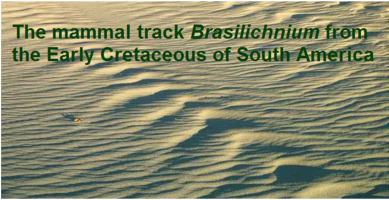Journal of South American Earth Sciences ( IF 1.7 ) Pub Date : 2020-10-23 , DOI: 10.1016/j.jsames.2020.102940 Giuseppe Leonardi , Ismar de Souza Carvalho

|
The ichnogenus Brasilichnium Leonardi, 1981 is an early mammal track, presently recognized in several continents, but originally found in the aeolian deposits of Botucatu Formation in the Paraná Basin, Brazil. The sandstones of the Botucatu Formation are generally fine-grained and well-sorted, containing no pebbles; its color can be white, yellowish or reddish, but more commonly it is pinkish. Nearly always, it is silicified and therefore compact and hard, making it a very suitable building material. These sedimentary rocks are interpreted as a Lower Cretaceous desert regarded as the largest paleodesert in the Earth's history. Although the aeolian environment is generally considered inadequate for track preservation, taphonomic events linked to moist dunes and microbial mats foster a good geological context for an early diagenization of the sediments. Brasilichnium is associated with a large ichnofauna of other mammal, theropod and ornithopod tracks, in addition to invertebrate traces. It is today a worldwide ichnogenus that allows an overview of the arid terrestrial ecosystems during Mesozoic. The presence of tritylodontids in the world after the end of the Triassic and up to the Late Cretaceous, and the possibility of attributing Brasilichnium and related ichnogenera to them, has been discussed at great length. It seems preferable, however, to suggest that these tracks can only belong to the crown-group Mammalia. Thus, these track-bearing deposits bear witness to small- and medium-size mammaliaform trackmakers; some of them would be remarkably larger than the coeval mammals represented by skeletal remains. This chronological discrepancy between ichnological and bone findings is not a surprising phenomenon: it is also known in other clades. A complete check of these tracks will have to be carried out. It would also be advisable to perform a review of all the tracks recently attributed to Brasilichnium world-wide. The Botucatu and Caiuá ichnofaunas and, globally, the ichnogenus Brasilichnium, should be stressed as an important window into the arid terrestrial ecosystems during the Gondwanic Cretaceous. This study is the result of forty-four years of research in the Botucatu Formation by the first author.
中文翻译:

回顾了南美下白垩纪的早期哺乳动物Brasilichnium和Brasilichnium类轨道
该遗迹属Brasilichnium伦纳迪(Leonardi),1981年是哺乳动物的早期踪迹,目前在几个大洲都得到了认可,但最初发现于巴西巴拉那盆地的Botucatu组风成沉积物中。Botucatu组的砂岩通常是细粒且分类良好,不含卵石。它的颜色可以是白色,淡黄色或淡红色,但更常见的是淡粉红色。它几乎总是被硅化,因此紧凑而坚硬,使其成为非常合适的建筑材料。这些沉积岩被解释为下白垩统沙漠,被认为是地球历史上最大的古沙漠。尽管通常认为风沙环境不足以保持航迹,但与潮湿的沙丘和微生物垫有关的自发事件促进了沉积物早期成岩的良好地质环境。Brasilichnium与大ichnofauna其他哺乳动物,兽脚类和鸟脚类曲目相关的,除了无脊椎动物的痕迹。今天,它已成为一种全球性的鱼类,可以概述中生代干旱的陆地生态系统。在三叠纪末期到白垩纪晚期,世界上存在三齿齿科,并可能归因于Brasilichnium以及与之相关的鱼腥藻已被详细讨论。但是,似乎最好建议这些轨道只能属于冠群哺乳动物。因此,这些带有轨迹的沉积物见证了中小型哺乳动物形式的跟踪器。其中一些将比以骨骼遗骸为代表的同龄哺乳动物大得多。鱼骨学和骨骼发现之间的时间顺序差异不足为奇:在其他进化枝中也是如此。必须对这些轨道进行全面检查。还建议对最近归因于世界各地的Brasilichnium的所有曲目进行审查。Botucatu和Caiuáichnofaunas,以及全球范围的ichnogenus Brasilichnium,应被视为冈瓦尼白垩纪进入干旱陆地生态系统的重要窗口。该研究是第一作者对Botucatu组进行了四十四年研究的结果。











































 京公网安备 11010802027423号
京公网安备 11010802027423号